The global prebiotic fiber market is worth USD 7.1 billion in 2025 and is expected to reach USD 13.1 billion by 2035, reflecting a CAGR of 6.3%. Growth in the market will be driven by rising awareness around gut health, increased incorporation of prebiotic ingredients in food and beverage applications, and growing preference for natural functional ingredients.
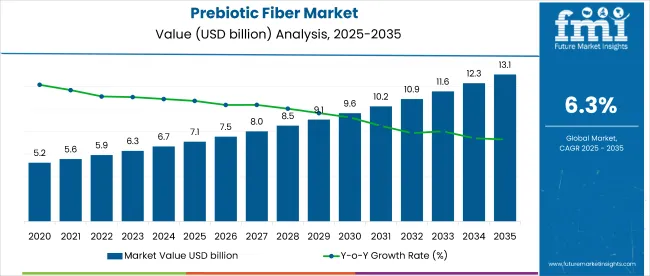
| Metric | Value |
|---|---|
| Estimated Size (2025E) | USD 7.1 billion |
| Projected Value (2035F) | USD 13.1 billion |
| CAGR (2025 to 2035) | 6.3% |
The aging global population, shifting consumer dietary habits, and the ongoing expansion of nutraceutical and dairy markets are further expected to boost demand over the forecast period.
Japan is projected to grow at a rapid pace of 6.4% CAGR, with demand driven by a deep-rooted consumer culture around digestive wellness. Meanwhile, the USA and the UK closely follow this significant growth with respective CAGRs of 6.1% and 5.8%. Galacto-oligosaccharides are set to dominate the product type segment with a 35% market share, supported by their increasing use in infant nutrition and bakery products. Meanwhile, the food & beverage application segment is anticipated to lead with a 45% share in 2025.
The market holds a notable share across several broader categories. Within the dietary fiber market, it accounts for 25%, driven by its specific functional benefits for gut health. In the digestive health ingredients market, prebiotic fiber comprises about 30%, given its central role in promoting microbiome balance.
It accounts for 18% of the nutraceutical ingredients market and around 15% of the functional food ingredients market. In the clean label ingredients market, it represents nearly 12%, supported by demand for natural, plant-derived solutions. Overall, prebiotic fiber is a high-impact niche with expanding influence across health-centric ingredient sectors.
Moving forward, market growth is expected to benefit from favorable government regulations supporting gut health claims on food labels and increasing R&D investment in natural fiber innovation. Innovations such as encapsulated prebiotic powders and customized fiber blends for personalized nutrition are being introduced. Moreover, rising interest in clean-label ingredients and the growth of plant-based product lines are expected to open new opportunities in both developed and emerging markets over the next decade.
ifThe global market is segmented into nature, product type, application, sales channel and region. By nature, the market is segmented into organic and conventional. By product type, the market includes galacto-oligosaccharide, fructo-oligosaccharide, mannan-oligosaccharide, inulin and others (polydextrose and resistant starch).
By application, the market provides food and beverages, baked foods, dairy, breakfast snacks, animal feed, nutritional supplements, and others (infant formula and dietary products). By sales channel, the market is segmented into direct sales, indirect sales, supermarket/hypermarket, online stores and retail stores. By Region, the market covers North America, Latin America, Europe, East Asia, South Asia, Oceania, the Middle East & Africa.
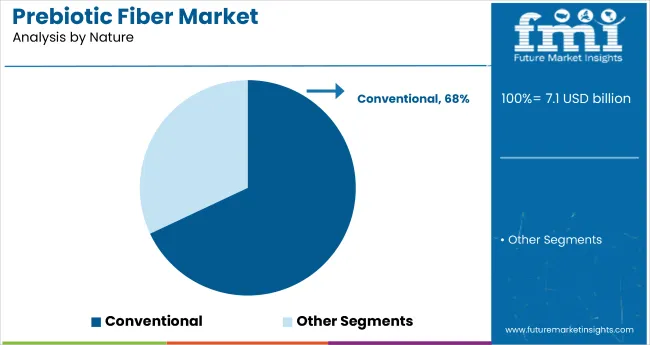
The conventional segment is projected to dominate the nature category, accounting for 68% of the market share in 2025. Its high availability and cost-effectiveness make conventional prebiotic fibers the preferred choice among both manufacturers and consumers. Most prebiotics used in processed foods and beverages are derived from traditional sources, ensuring scalability and consistent supply.
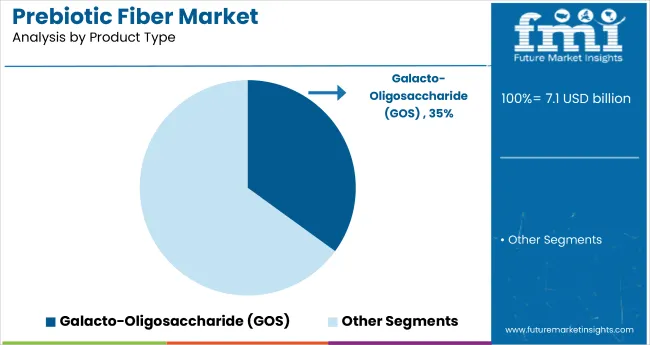
Galacto-oligosaccharide (GOS) is projected to lead the product type segment with a 35% market share in 2025. GOS offers multiple health benefits, including promoting bifidobacteria growth, reducing the risk of colon cancer, and alleviating constipation. Its increasing use in infant formula and baked goods, along with low caloric content, supports wider adoption. The clean-label and non-GMO status of many GOS ingredients is further contributing to segment growth.
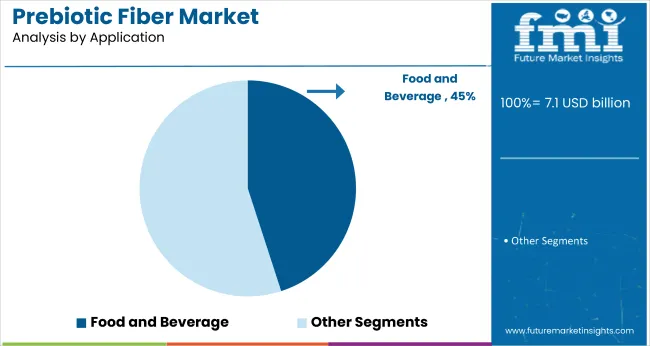
The food and beverage is anticipated to dominate the application segment with a 45% share in 2025. Rising demand for fortified products, functional beverages, and health-focused snacks has accelerated the use of prebiotic fiber in this category. Growing consumer interest in gut health is prompting manufacturers to incorporate prebiotics into dairy, beverages, and baked goods.
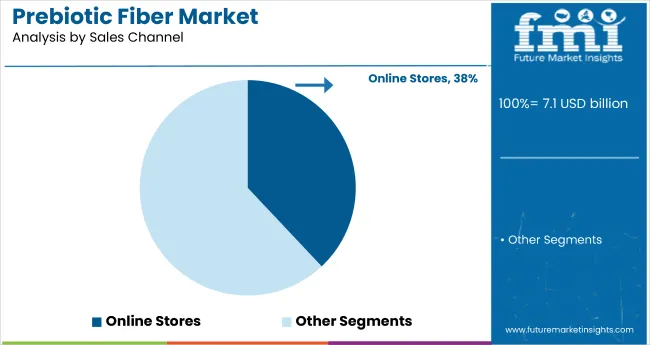
Online stores are projected to lead the sales channel segment with a 38% share in 2025. The convenience of e-commerce platforms, broader product visibility, and rising consumer trust in digital purchases have made this channel highly lucrative. The increasing popularity of health supplements and fiber-enriched products is fueling the growth of online health food retailers and specialty nutrition marketplaces, particularly in urban areas.
Recent Trends in the Prebiotic Fiber Market
Key Challenges in the Prebiotic Fiber Market
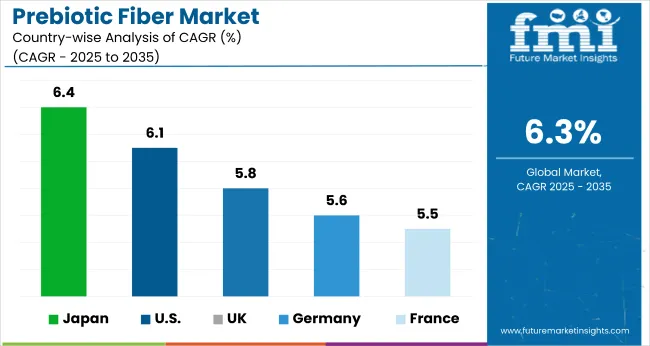
Among the top countries in the market, Japan is projected to register the highest CAGR at 6.4% from 2025 to 2035, driven by a deep-rooted digestive health culture, aging population concerns, and continuous innovation in functional foods and beverages.
The USA follows closely with a 6.1% CAGR, supported by the country’s high intake of dietary supplements, growing awareness of gut health, and widespread adoption of functional food formats. In the UK, the market is expected to expand at a 5.8% CAGR, fueled by clean-label preferences, plant-based food innovation, and strong veganism trends.
Meanwhile, Germany is forecasted to grow at 5.6%, underpinned by research-backed ingredient demand and increasing fortified dairy consumption. France, at 5.5% CAGR, benefits from a combination of product reformulation initiatives and rising interest in organic digestive health solutions, especially in yogurts and cereals. Together, these five countries are shaping the global trajectory of the prebiotic fiber market.
The report covers an in-depth analysis of 40+ countries; five top-performing OECD countries are highlighted below.
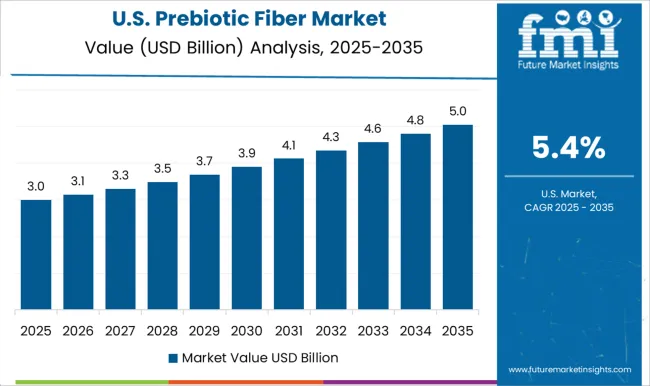
Prebiotic fiber revenue in the USA is projected to grow at a CAGR of 6.1% from 2025 to 2035. Growth is driven by rising demand for gut health supplements, broad awareness of digestive wellness, and increased use of prebiotic fiber in fortified food products. Prebiotics are increasingly incorporated into sports nutrition, dairy alternatives, and breakfast cereals targeting health-conscious consumers.
The prebiotic fiber market in the UK is expected to grow at a CAGR of 5.8% from 2025 to 2035. Rising adoption of prebiotic dietary supplements and growing preference for organic products are fueling market demand. The shift toward vegan and plant-based diets is accelerating the use of prebiotic fiber in bakery items, non-dairy yogurts, and nutrition bars.

Sales of prebiotic fiber in Germany are projected to grow at a CAGR of 5.6% from 2025 to 2035. The country remains a key innovation hub in Europe, with a strong presence of health food brands and research-driven supplement manufacturers. Prebiotic fibers such as inulin and GOS are widely used in functional yogurts, digestive shots, and health drinks.
Revenue from prebiotic fiber in France is expected to grow at a CAGR of 5.5% from 2025 to 2035. The country is experiencing steady demand for natural digestive aids and functional foods. Market growth is supported by France’s active involvement in clinical trials and dietary fiber awareness campaigns. Functional beverages and premium nutritional supplements are increasingly being fortified with prebiotics.
The prebiotic fiber market in Japan is projected to grow at a CAGR of 6.4% from 2025 to 2035. This surge is fueled by the country’s deep-rooted emphasis on gut health, widespread consumption of fermented foods, and increasing demand for functional beverages. An aging population and interest in preventive nutrition are also driving innovation in digestive wellness products.
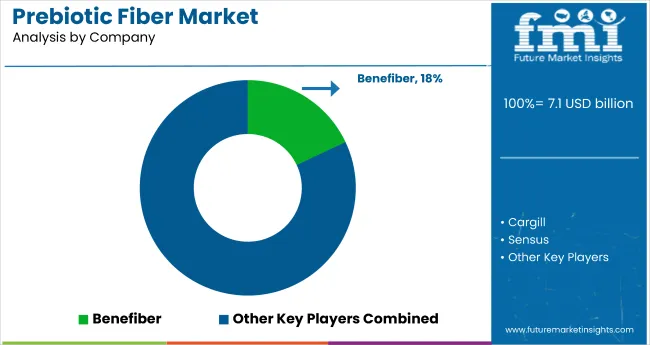
The market is moderately fragmented, with several key players operating across functional food, dietary supplements, and nutraceutical sectors. Prominent companies such as Cargill, FrieslandCampina Domo, Now Foods, and Sensus dominate due to strong product portfolios and global distribution capabilities. These companies are competing on pricing strategies, formulation innovation, strategic partnerships with health food brands, and regional expansion into high-growth markets such as Asia Pacific and Latin America.
Company strategies are increasingly focused on launching clinically supported fiber blends, expanding into e-commerce, and scaling sustainable production. Leading players are aligning product development with consumer demand for organic, non-GMO, and clean-label ingredients. Additionally, strategic acquisitions and R&D collaborations are enabling firms like Cargill and FrieslandCampina to tap into emerging application segments, such as infant nutrition and personalized gut health solutions.
| Report Attributes | Details |
|---|---|
| Current Total Market Size (2025) | USD 7.1 billion |
| Projected Market Size (2035) | USD 13.1 billion |
| CAGR (2025 to 2035) | 6.3% |
| Base Year for Estimation | 2024 |
| Historical Period | 2020 to 2024 |
| Projections Period | 2025 to 2035 |
| Market Analysis Parameters | Revenue in USD billions / Volume in metric tons |
| By Nature | Organic and Conventional |
| By Product Type | Galacto-Oligosaccharide, Fructo-Oligosaccharide, Mannan-Oligosaccharide, Inulin, and Others |
| By Sales Channel | Direct Sales, Indirect Sales, Supermarket/Hypermarket, Online Stores, Retail Stores |
| By Application | Food and Beverages, Baked Food, Dairy, Breakfast Snacks, Animal Feed, Nutritional Supplements, Others |
| Regions Covered | North America, Latin America, Europe, East Asia, South Asia, Oceania, the Middle East and Africa |
| Countries Covered | United States, Canada, United Kingdom, Germany, France, China, Japan, South Korea, Brazil, Australia and 40+ Countries |
| Key Players | Benefiber, Prebiotin, Now Foods, Cargill, Sensus, Kraft Foods Inc., Yakult Honsha Co. Ltd., KeVita, Maveron, Evolve Biosystems, Attune Foods, Indiebio, BioGaia, Solvay Pharmaceuticals SA, Roquette America Inc., FrieslandCampina Domo, Cosucra Groupe Warcoing SA, GTC Nutrition, and Parmalat S.p.A. |
| Additional Attributes | Dollar sales by value, segment-wise market share, and country-level growth insights provided to guide strategic decisions, identify high-potential regions, and evaluate key application and product trends across the forecast period |
The global prebiotic fiber market is estimated to be valued at USD 7.1 billion in 2025.
The market size for the prebiotic fiber market is projected to reach USD 13.1 billion by 2035.
The prebiotic fiber market is expected to grow at a 6.3% CAGR between 2025 and 2035.
The key product types in prebiotic fiber market are organic and conventional.
In terms of product type, galacto-oligosaccharide segment to command 47.6% share in the prebiotic fiber market in 2025.






Our Research Products

The "Full Research Suite" delivers actionable market intel, deep dives on markets or technologies, so clients act faster, cut risk, and unlock growth.

The Leaderboard benchmarks and ranks top vendors, classifying them as Established Leaders, Leading Challengers, or Disruptors & Challengers.

Locates where complements amplify value and substitutes erode it, forecasting net impact by horizon

We deliver granular, decision-grade intel: market sizing, 5-year forecasts, pricing, adoption, usage, revenue, and operational KPIs—plus competitor tracking, regulation, and value chains—across 60 countries broadly.

Spot the shifts before they hit your P&L. We track inflection points, adoption curves, pricing moves, and ecosystem plays to show where demand is heading, why it is changing, and what to do next across high-growth markets and disruptive tech

Real-time reads of user behavior. We track shifting priorities, perceptions of today’s and next-gen services, and provider experience, then pace how fast tech moves from trial to adoption, blending buyer, consumer, and channel inputs with social signals (#WhySwitch, #UX).

Partner with our analyst team to build a custom report designed around your business priorities. From analysing market trends to assessing competitors or crafting bespoke datasets, we tailor insights to your needs.
Supplier Intelligence
Discovery & Profiling
Capacity & Footprint
Performance & Risk
Compliance & Governance
Commercial Readiness
Who Supplies Whom
Scorecards & Shortlists
Playbooks & Docs
Category Intelligence
Definition & Scope
Demand & Use Cases
Cost Drivers
Market Structure
Supply Chain Map
Trade & Policy
Operating Norms
Deliverables
Buyer Intelligence
Account Basics
Spend & Scope
Procurement Model
Vendor Requirements
Terms & Policies
Entry Strategy
Pain Points & Triggers
Outputs
Pricing Analysis
Benchmarks
Trends
Should-Cost
Indexation
Landed Cost
Commercial Terms
Deliverables
Brand Analysis
Positioning & Value Prop
Share & Presence
Customer Evidence
Go-to-Market
Digital & Reputation
Compliance & Trust
KPIs & Gaps
Outputs
Full Research Suite comprises of:
Market outlook & trends analysis
Interviews & case studies
Strategic recommendations
Vendor profiles & capabilities analysis
5-year forecasts
8 regions and 60+ country-level data splits
Market segment data splits
12 months of continuous data updates
DELIVERED AS:
PDF EXCEL ONLINE
Prebiotic Deodorants Market Analysis - Size and Share Forecast Outlook 2025 to 2035
Prebiotic Ingredient Market Analysis - Size, Share, and Forecast 2025 to 2035
Prebiotic Soda Market Analysis by Type, Packaging, Flavor and Distribution Channel Through 2035
Prebiotic Coffee Market Analysis by Product Type, Format and Other Distribution Channel Through 2035
Pet Prebiotics Market Analysis - Size, Growth, and Forecast 2025 to 2035
Marine Prebiotics Market Size and Share Forecast Outlook 2025 to 2035
Animal Feed Prebiotics Market – Growth, Livestock Nutrition & Demand
Demand for Whey-plus-Prebiotic Stacks for RTD Shakes in CIS Analysis Size and Share Forecast Outlook 2025 to 2035
Fiberglass Centrifugal Fan Market Size and Share Forecast Outlook 2025 to 2035
Fiber to the Home Market Size and Share Forecast Outlook 2025 to 2035
Fiber Based Packaging Market Size and Share Forecast Outlook 2025 to 2035
Fiber Lid Market Forecast and Outlook 2025 to 2035
Fiberglass Tanks Market Size and Share Forecast Outlook 2025 to 2035
Fiber Sorter Market Size and Share Forecast Outlook 2025 to 2035
Fiber Reinforced Polymer Panel and Sheet Market Size and Share Forecast Outlook 2025 to 2035
Fiber Optic Tester Market Size and Share Forecast Outlook 2025 to 2035
Fiber Laser Market Size and Share Forecast Outlook 2025 to 2035
Fiberglass Market Size and Share Forecast Outlook 2025 to 2035
Fiber Spinning Equipment Market Size and Share Forecast Outlook 2025 to 2035
Fiber Reinforced Plastic (FRP) Panels & Sheets Market Size and Share Forecast Outlook 2025 to 2035

Thank you!
You will receive an email from our Business Development Manager. Please be sure to check your SPAM/JUNK folder too.
Chat With
MaRIA